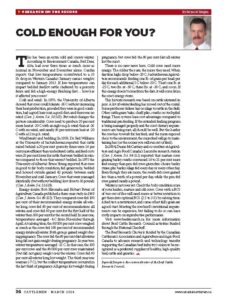Cold Enough for You?
This article written by Dr. Reynold Bergen, BCRC Science Director, originally appeared in the March 2014 issue of Canadian Cattlemen magazine and is reprinted on the BCRC Blog with permission.

Red Deer, Alberta had three times as much snow as normal last November and December. This winter brought more snow and cold to the rest of Canada as well. Canfax reports that low temperatures contributed to a 35lb drop in Western Canada’s January carcass weights compared to January 2013. If low temperatures can impact bedded feedlot cattle sheltered by a porosity fence and fed a high energy finishing diet… how has it affected your cows?
Cold and wind: In 1970, the University of Alberta showed that cows could tolerate -26oC without increasing their heat production, provided they were in good condition, had a good hair coat, a good diet, and there was no wind (Can. J. Anim. Sci. 50:563). But wind changes the picture considerably. Cows need to produce 20% more heat at -20oC with an 8mph wind than at -26oC with no wind, and nearly 30% more heat at -20oC with a 12mph wind.
Windbreaks and bedding
In 1959, Dr. Red Williams at the University of Saskatchewan reported that cattle raised behind a 20% porosity fence were 18% more efficient than unsheltered cattle. Feed costs were 25% lower for cattle that were bedded in winter compared to those that weren’t bedded. In 1975 the University of Alberta’s Bruce Young reported that cows in good to fat body condition, fed generously, bedded and housed outside gained 42lbs between early November and mid-January. Cows that were managed identically (but without bedding) lost close to 10lbs (Can. J. Anim. Sci. 55:619).
Energy intake
Bob Hironaka and Hobart Peters of Agriculture Canada published a three year study in 1969 (Can. J. Anim. Sci. 49:323). They compared cows fed 100% of their recommended energy intake all winter long, cows fed 80% of recommendations all winter, and cows fed 80% for the first half of the winter then 100% for the second half. In year 1, temperatures averaged -4oC from November through April. At calving time, the 80%/100% cows weighed as much as the cows fed 100% of recommended energy intake all winter. Both groups gained weight during pregnancy. The cows fed the 80% diet all winter long did not gain weight during pregnancy. In year 2, winter temperatures averaged -15oC. In that case, the 100% cows and the 80%/100% cows maintained (but did not gain) weight over the winter. Cows fed 80% all winter lost weight. The third year was warmer (-7oC), but the coldest temperatures occurred in the last third of pregnancy. All groups lost weight during pregnancy, but cows fed the 80% diet all winter lost the most.
There is no new news here. Cold cows need more energy. The colder they are, the more they need. When daytime highs drop below -20oC, Saskatchewan Agriculture recommends feeding 1lb of grain per head per day for each additional 5oC below -20oC. That’s 1lb at -25oC, 2lbs at -30oC, 3lbs at -30oC, and so on. If this energy doesn’t come from the diet, it will come from the cow’s energy stores.
This historic research was based on cattle wintered in pens. A lot of winter feeding has moved out of the corral. Some producers deliver hay or silage to cattle in the field. Other cattle graze bales, chaff piles, swaths or stockpiled forage. These systems have cost advantages compared to traditional pen feeding. If the extended feeding program is being managed properly and the cow’s dietary requirements are being met, all should be well. But the harder the cow has to work for her feed, and the more exposed she is to the environment, the more feed will go to maintaining her (or the sooner you will run out of feed).
In 2004, Duane McCartney and co-workers at Agriculture and Agri-Food Canada’s Lacombe research station (Can. J. Anim. Sci. 84:511) reported that mature cows grazing barley swaths consumed 18 to 21% more feed energy than pen-fed cows given free-choice barley straw, plus barley silage fed every day or every other day. Even though they ate more, the swath fed cows gained less than a tenth of a pound per day, while the pen-fed cows gained nearly a pound.
Winter is not over yet. Check the body condition score of your heifers, mature and old cows. Cows with a BCS of 2 out of 5 will need more or better nutrition to get them into optimal BCS (2.5 to 3.0) by calving time. A feed test, a nutritionist, and some of last fall’s grain are a good start. Meeting the cow herd’s nutritional requirements can be expensive, but failing to do so can have costly impacts on reproductive performance.
Click here to subscribe to the BCRC Blog and receive email notifications when new content is posted.
The sharing or reprinting of BCRC Blog articles is typically welcome and encouraged, however this article requires permission of the original publisher.
We welcome your questions, comments and suggestions. Contact us directly or generate public discussion by posting your thoughts below.